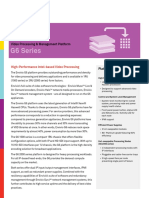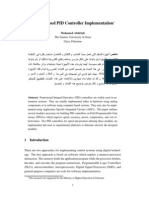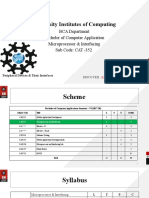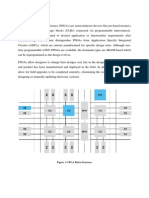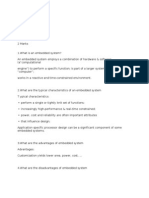L5 Digital System Modeling1
L5 Digital System Modeling1
Uploaded by
madhu ningareddyCopyright:
Available Formats
L5 Digital System Modeling1
L5 Digital System Modeling1
Uploaded by
madhu ningareddyOriginal Description:
Copyright
Available Formats
Share this document
Did you find this document useful?
Is this content inappropriate?
Copyright:
Available Formats
L5 Digital System Modeling1
L5 Digital System Modeling1
Uploaded by
madhu ningareddyCopyright:
Available Formats
EC806 DDFPGA
Modeling of Digital Systems
Dr Sumam David S.
EC806
Objectives
• At the end of the lecture the student
must be able to
– Appreciate top-down design methodology,
need for HDL, and choose level of
abstraction for modeling a digital system
Page 2 DDFPGA September 2022
Dept of E&C, NITK Surathkal 1
EC806 DDFPGA
FPGA based Design Flow
Page 3 DDFPGA September 2022
What is inside an ASIC or an FPGA?
Page 4 DDFPGA September 2022
Dept of E&C, NITK Surathkal 2
EC806 DDFPGA
What is inside an ASIC or an FPGA?
Page 5 DDFPGA September 2022
What is inside an ASIC or an FPGA?
Page 6 DDFPGA September 2022
Dept of E&C, NITK Surathkal 3
EC806 DDFPGA
What is inside an ASIC or an FPGA?
Page 7 DDFPGA September 2022
What is inside an ASIC or an FPGA?
You are writing HDL code to get this image automatically using the tools
Page 8 DDFPGA September 2022
Dept of E&C, NITK Surathkal 4
EC806 DDFPGA
Different Tools?
• Cadence
• Synopsys
• Mentor Graphics
• Xilinx
• Intel Altera – Quartus
• Open source tools
Page 9 DDFPGA September 2022
Fabrication facilities
• SCL Chandigarh – under ISRO
• UMC
• TSMC
• Global foundries
• Intel
• Samsung ….etc.
Page 10 DDFPGA September 2022
Dept of E&C, NITK Surathkal 5
EC806 DDFPGA
FPGA
Logic blocks
Implement combinational
and sequential logic
Interconnect
Wires to connect inputs
and outputs to logic
blocks
I/O blocks
Special logic blocks at
periphery of device for
external connections
Page 11 DDFPGA September 2022
Modeling digital systems
• Model
– Represents info that is relevant and abstracts away details
– Context dependent
• Reasons for modeling
– Requirements specification
– Documentation
– Testing using simulation
– Formal verification
– Synthesis
– Design reuse
• Goal
– Most reliable design process, with minimum cost and time
– Avoid design errors!
Page 12 DDFPGA September 2022
Dept of E&C, NITK Surathkal 6
EC806 DDFPGA
Domains
• Digital systems modeled in 3 principal domains and
at different levels of abstraction
• Behavioral
– What does it do?
– Truth table, state diagram, waveform, algo
• Structural
– What are the components and how are they connected ?
– Schematic, net list
• Physical
– Where are the components located on Si/PCB ?
– Placement & routing
Page 13 DDFPGA September 2022
Behavioural view
• What the system does
• Info on how this will be achieved is hidden
• Inputs and outputs are defined along with
the relationship between them
• Examples
– Truth table
A
– State diagram B
Y=A+B Y
– Waveform
– Algorithm
Page 14 DDFPGA September 2022
Dept of E&C, NITK Surathkal 7
EC806 DDFPGA
Structural
• What the design is
– What components are used
– How are they interconnected
• No info on what the system does nor how it will be
made
• Example
– Schematic
– Net list
• The components may be defined using behavioral or
structural description
– hierarchical description
Page 15 DDFPGA September 2022
Physical
• How the design is made
• Placement & routing or Manufacturing info
• No info on what components are being made nor on how they
behave
• PCB manufacture
– GERBER files
• Etching tracks, drilling holes
• IC layout
– GDS2 files
• Mask layout: diffusion, metal …
• PLDs
– JEDEC files
• Define internal connections
Page 16 DDFPGA September 2022
Dept of E&C, NITK Surathkal 8
EC806 DDFPGA
Example
• Controller for a temperature
measurement system with data input
and display output
Page 17 DDFPGA September 2022
Domains and Levels of Modeling
Structural Behavioral
high level of
abstraction
low level of
abstraction
Physical “Y-chart” due to
Gajski & Kahn
Page 18 DDFPGA September 2022
Dept of E&C, NITK Surathkal 9
EC806 DDFPGA
Domains and Levels of
Modeling
Structural Behavioral
Algorithm
(behavioral)
Register-Transfer
Language
Boolean Equation
Differential Equation
Physical “Y-chart” due to
Gajski & Kahn
Page 19 DDFPGA September 2022
Behavioral domain - levels
• Algorithm
– The set of operations to be performed
• Register Transfer Language
– How data will be moved and stored
• Boolean Equations
– How individual signals are manipulated
• Differential equations
– How currents and voltages in the transistors
behave
Page 20 DDFPGA September 2022
Dept of E&C, NITK Surathkal 10
EC806 DDFPGA
Domains and Levels of
Modeling
Structural Behavioral
Processor-Memory
Switch
Register-Transfer
Gate
Transistor
Physical “Y-chart” due to
Gajski & Kahn
Page 21 DDFPGA September 2022
Levels of abstraction
Page 22 DDFPGA September 2022
Dept of E&C, NITK Surathkal 11
EC806 DDFPGA
Domains and Levels of
Modeling
Structural Behavioral
Polygons
Sticks
Standard Cells
Floor Plan
Physical “Y-chart” due to
Gajski & Kahn
Page 23 DDFPGA September 2022
Adv…
• Automatic synthesis
• Testing & verification using simulation
• Formal verification
• Max reliability for min cost & design
time
• Design reuse
Page 24 DDFPGA September 2022
Dept of E&C, NITK Surathkal 12
EC806 DDFPGA
RTL (dataflow) descriptions
• Describes system in terms of units of data
storage and transformation
• Datapath
– Data storage registers and data
transfer between these units
– Implemented by registers and logic
• Control path
• Sequences operations of the datapath components
• Implemented by FSM
Page 25 DDFPGA September 2022
RTL description
Data in Data out
Data path
Control Status
External External
Control path
Control in Control out
Page 26 DDFPGA September 2022
Dept of E&C, NITK Surathkal 13
EC806 DDFPGA
Datapath
CL R Data Data CL Data
Data in
out in out
Control Load
• storage of data and constants
Data in CL R Data • data transfer
out • data transformations
Control Load
Page 27 DDFPGA September 2022
Control path
inputs outputs
CL
Present next state
state
FSM
• activates operations in data path via control signals
• uses status & external control signals for decision making
Page 28 DDFPGA September 2022
Dept of E&C, NITK Surathkal 14
EC806 DDFPGA
RTL Design method
• Specify the behavior of the system
• Design the data path
• Design the control path
• Implement the data and control path
– Specify the interface between datapath
and control path in terms of explicit signals
– structural model
Page 29 DDFPGA September 2022
Example - Serial Adder
Page 30 DDFPGA September 2022
Dept of E&C, NITK Surathkal 15
You might also like
- Envivio G6 Series DS-2015-05 r01Document3 pagesEnvivio G6 Series DS-2015-05 r01saefulNo ratings yet
- FAST - MS - ICD - Brochure - Fall - 2021Document1 pageFAST - MS - ICD - Brochure - Fall - 2021Hassaan AhmedNo ratings yet
- Jithendra PulivarthiDocument1 pageJithendra PulivarthialoktucerNo ratings yet
- FPGA-Based PID Controller ImplementationDocument20 pagesFPGA-Based PID Controller ImplementationShahrzad GhasemiNo ratings yet
- FPGAs - CHRONOLOGICAL DEVELOPMENTS AND CHALLENGESDocument13 pagesFPGAs - CHRONOLOGICAL DEVELOPMENTS AND CHALLENGESIAEME PublicationNo ratings yet
- FPGA-Based PID Controller ImplementationDocument19 pagesFPGA-Based PID Controller Implementationchoc_ngoay1No ratings yet
- Fundamental Logic DesignDocument55 pagesFundamental Logic DesignSenay MehariNo ratings yet
- 08-iie-msa-bachelor-of-computer-and-information-science-factsheet-2024eDocument4 pages08-iie-msa-bachelor-of-computer-and-information-science-factsheet-2024eDavediorNo ratings yet
- FPGA Lect3Document93 pagesFPGA Lect3Amit JoshiNo ratings yet
- DOC-20240613-WA0000.Document15 pagesDOC-20240613-WA0000.Kallu kaliaNo ratings yet
- A Study of FPGA-based System-on-Chip DesignsDocument12 pagesA Study of FPGA-based System-on-Chip DesignsZ e u s V e n i f i c u sNo ratings yet
- Multi-Vendor Interoperability in IEC 61850 SystemsDocument31 pagesMulti-Vendor Interoperability in IEC 61850 SystemsBernardoNo ratings yet
- Design and Implementation of Real Time Data AcquisDocument8 pagesDesign and Implementation of Real Time Data AcquisER. MANISHNo ratings yet
- Implementation of First Order Statistical Processor On FPGA For Feature ExtractionDocument10 pagesImplementation of First Order Statistical Processor On FPGA For Feature ExtractionIJRES teamNo ratings yet
- Introduction To Field Programmable Gate Arrays AND Its ApplicationsDocument13 pagesIntroduction To Field Programmable Gate Arrays AND Its ApplicationsParidhi NagoriNo ratings yet
- VLSIDocument9 pagesVLSIAnandhakrishnan P ANo ratings yet
- HDAP Signoff Mentor2018Document27 pagesHDAP Signoff Mentor2018wwang.szNo ratings yet
- QP - SSC - Q8113 - v2.0 - AI Machine Learning EngineerDocument40 pagesQP - SSC - Q8113 - v2.0 - AI Machine Learning Engineerprakash subramanianNo ratings yet
- Cat-352 MP Unit 3.1Document23 pagesCat-352 MP Unit 3.1Ashish YadavNo ratings yet
- New Interaction Paradigm For Complex Eda SoftwareDocument8 pagesNew Interaction Paradigm For Complex Eda SoftwareMar NHNo ratings yet
- IT-ITeS Q8210 IoT - Domain Specialist Qualification FileDocument28 pagesIT-ITeS Q8210 IoT - Domain Specialist Qualification FileAnand AmsuriNo ratings yet
- VIT WKSPDocument75 pagesVIT WKSPkishorechiyaNo ratings yet
- Verification Techniques of FPGA DesignsDocument39 pagesVerification Techniques of FPGA DesignsAnil Kumar GorantalaNo ratings yet
- Hard and Soft Embedded FPGA Processor Systems Design: Design Considerations and Performance ComparisonsDocument22 pagesHard and Soft Embedded FPGA Processor Systems Design: Design Considerations and Performance ComparisonsRohan PeterNo ratings yet
- EDA词条Document1 pageEDA词条houhuamilanNo ratings yet
- KingSCADA Training PDFDocument148 pagesKingSCADA Training PDFeman71No ratings yet
- Edt180 TechtalkDocument13 pagesEdt180 Techtalkapi-446563821No ratings yet
- FPGA To ASIC CONVERSION-RPTDocument31 pagesFPGA To ASIC CONVERSION-RPTSangeeta SoniNo ratings yet
- An Introduction To FPGADocument38 pagesAn Introduction To FPGADr-Eng Imad ShaheenNo ratings yet
- Shah Junaed Al Amin PDFDocument5 pagesShah Junaed Al Amin PDFMD Nazmul Hossain SunnyNo ratings yet
- I-Quad Technologies: Course PropasalDocument2 pagesI-Quad Technologies: Course PropasalAmbareeshNo ratings yet
- Sample Closing ReportDocument16 pagesSample Closing Reportg.shanmugaNo ratings yet
- RTL Design of Cisc Cpu Ip CoreDocument8 pagesRTL Design of Cisc Cpu Ip CoreIJRASETPublicationsNo ratings yet
- What Is An FPGA?: Figure 1: FPGA Block StructureDocument10 pagesWhat Is An FPGA?: Figure 1: FPGA Block Structureacer551100% (1)
- BE - 29 Project Group 29Document13 pagesBE - 29 Project Group 29Rohit PingaleNo ratings yet
- Current Graphics Card Analysis & New Design Concept: Bachelor S Thesis Information Technology Hardware Design 2015Document43 pagesCurrent Graphics Card Analysis & New Design Concept: Bachelor S Thesis Information Technology Hardware Design 2015Ahmed HusseinNo ratings yet
- 14S4003 Introduction To Embedded System: Semester 1 2020/2021Document19 pages14S4003 Introduction To Embedded System: Semester 1 2020/2021Yohana Crisma LimbongNo ratings yet
- IG-MTechVLSI-1-DSD-Unit1-Lec2Document23 pagesIG-MTechVLSI-1-DSD-Unit1-Lec2Abhishek abhishekNo ratings yet
- How To Implement - All-Digital - Analog-To-Digital Converters in FPGAs and ASICs - EE TimesDocument11 pagesHow To Implement - All-Digital - Analog-To-Digital Converters in FPGAs and ASICs - EE TimesAshok kumarNo ratings yet
- Harshit S ResumeDocument1 pageHarshit S ResumeHARSHIT KUMAR SHAKYANo ratings yet
- Embedded Processors On FPGA: Soft Vs Hard: Vivek JayakrishnanDocument8 pagesEmbedded Processors On FPGA: Soft Vs Hard: Vivek JayakrishnanTechnical NoviceNo ratings yet
- Akash Vitthal GiddeDocument2 pagesAkash Vitthal Giddeshubham.moNo ratings yet
- Ieee FpgaDocument3 pagesIeee FpgaZ e u s V e n i f i c u sNo ratings yet
- Customizing The Pci AddDocument91 pagesCustomizing The Pci Addkoreh76941No ratings yet
- Breakdown The Silos: Dataops and Data Models For Manufacturing OperationsDocument30 pagesBreakdown The Silos: Dataops and Data Models For Manufacturing OperationsQadir MohtashamNo ratings yet
- Idsw122 23 1 v1Document110 pagesIdsw122 23 1 v1SanketNo ratings yet
- Ashutosh Rana ResumeDocument1 pageAshutosh Rana ResumetushartrayNo ratings yet
- CUST103 Gioultouridis 20150608 2338-1Document26 pagesCUST103 Gioultouridis 20150608 2338-1Kishore KNo ratings yet
- Unit I Embedded SystemDocument42 pagesUnit I Embedded Systemkarthick707No ratings yet
- MJC 010233Document6 pagesMJC 010233raduseicaNo ratings yet
- Sanjay's ResumeDocument1 pageSanjay's Resumesanjayr112018No ratings yet
- Poster 3891Document1 pagePoster 3891Virgo SniderNo ratings yet
- IET Circuits Devices Syst - 2019 - Pandey - Hardware Architectures For PRESENT Block Cipher and Their FPGADocument12 pagesIET Circuits Devices Syst - 2019 - Pandey - Hardware Architectures For PRESENT Block Cipher and Their FPGAminhuocbalamNo ratings yet
- A Reconfigurable Model-Based Design For Rapid Prototyping On FPGADocument6 pagesA Reconfigurable Model-Based Design For Rapid Prototyping On FPGAKhaled IsmailNo ratings yet
- Harshith SKDocument1 pageHarshith SKHarshith S KNo ratings yet
- 21ec503 Vlsi Design Unit VDocument64 pages21ec503 Vlsi Design Unit VsanthoshiniNo ratings yet
- Embedded Systems Unit I Part A (2 Marks)Document47 pagesEmbedded Systems Unit I Part A (2 Marks)Vijaya KumarNo ratings yet
- VLSI Digital Design Using VHDL and FPGADocument22 pagesVLSI Digital Design Using VHDL and FPGAMervat MahmoudNo ratings yet
- Foundation Course VLSI Front End EditableDocument12 pagesFoundation Course VLSI Front End Editableumair saifullahNo ratings yet
- Ec8552-Cao Unit 5Document72 pagesEc8552-Cao Unit 5Anonymous c75J3yX33No ratings yet
- FPGA Programming for Beginners: Bring your ideas to life by creating hardware designs and electronic circuits with SystemVerilogFrom EverandFPGA Programming for Beginners: Bring your ideas to life by creating hardware designs and electronic circuits with SystemVerilogNo ratings yet
- UBA Quick ReferenceDocument20 pagesUBA Quick ReferenceDan KollanderNo ratings yet
- TRIMUser SetupDocument6 pagesTRIMUser SetupAzman AhmadNo ratings yet
- LibFredo6 User Manual - English - V4.0Document12 pagesLibFredo6 User Manual - English - V4.0costalandNo ratings yet
- The Sorcerer's Apprentice Guide To Fault Attacks: Proceedings of The IEEE August 2004Document14 pagesThe Sorcerer's Apprentice Guide To Fault Attacks: Proceedings of The IEEE August 2004Rémi GilliotNo ratings yet
- Manual Acer Verition Z2610GDocument132 pagesManual Acer Verition Z2610GSook SabuyNo ratings yet
- DOP-W105B / DOP-W127B / DOP-W157B Instrunction Sheet: (3) Pin Definition of Serial CommunicationDocument8 pagesDOP-W105B / DOP-W127B / DOP-W157B Instrunction Sheet: (3) Pin Definition of Serial CommunicationFranc Magny EssecofyNo ratings yet
- Unit 3: Microcomputers and Microprocessors: Lesson 1: Microcomputer and OrganizationDocument18 pagesUnit 3: Microcomputers and Microprocessors: Lesson 1: Microcomputer and OrganizationAbdullahel ShafiNo ratings yet
- Upgrade Internals 19cDocument178 pagesUpgrade Internals 19ctruemadhuNo ratings yet
- TA357 Asset MGMT v1.0 (IBM Edits)Document21 pagesTA357 Asset MGMT v1.0 (IBM Edits)Joey ANo ratings yet
- Object Oriented Programming Course PlanDocument4 pagesObject Oriented Programming Course PlanAbdurezak AkmelNo ratings yet
- Christopher Fernando: PeopleDocument3 pagesChristopher Fernando: PeopleUtkarsh SrivastavaNo ratings yet
- Furniture OrderDocument3 pagesFurniture OrderAdrian PhNo ratings yet
- 18CS73Document2 pages18CS73Vicky VikasNo ratings yet
- Programming Playstation 2Document13 pagesProgramming Playstation 24gen_7No ratings yet
- Nanocam C1U Datasheet: Camera Payload For Nano-SatellitesDocument13 pagesNanocam C1U Datasheet: Camera Payload For Nano-SatellitesERNESTONo ratings yet
- CS Class XII PaperDocument7 pagesCS Class XII PaperYash gehlotNo ratings yet
- Manual KOHTECT QB - 701Document30 pagesManual KOHTECT QB - 701vains_marcosNo ratings yet
- Rocam-NC300-Quick Installtion Guide-Version2.2-0527cDocument22 pagesRocam-NC300-Quick Installtion Guide-Version2.2-0527cFilipe ismaolNo ratings yet
- TEAC LCDV1501M Service ManualDocument94 pagesTEAC LCDV1501M Service ManualRoger Martínez BermúdezNo ratings yet
- Digital Signal ProcessingDocument354 pagesDigital Signal ProcessingAlcides Ramos Zambrano100% (4)
- Tableau Interview IMP QuestionsDocument5 pagesTableau Interview IMP QuestionsRajeshKumarInjamalaNo ratings yet
- Instant Download Windows 10 Inside Out 3rd Edition Ed Bott PDF All ChapterDocument64 pagesInstant Download Windows 10 Inside Out 3rd Edition Ed Bott PDF All Chapterzjuzixchima100% (6)
- 4600 Appliance DatasheetDocument5 pages4600 Appliance DatasheetAnh Bui Tuan0% (1)
- Youngzsoft Company ProfileDocument9 pagesYoungzsoft Company Profilehuracanrojo94No ratings yet
- Creating The Recovery Catalog Schema in The Recovery Catalog DatabaseDocument17 pagesCreating The Recovery Catalog Schema in The Recovery Catalog Databaseapi-19920581No ratings yet
- IBM Java 1.5 Diagnostics Guide PDFDocument468 pagesIBM Java 1.5 Diagnostics Guide PDFnguoituyet02No ratings yet
- MCQ-4 StringDocument7 pagesMCQ-4 StringCatalyst GamingNo ratings yet
- CollabCAD Getting Started Tutorial V1.1Document15 pagesCollabCAD Getting Started Tutorial V1.1Sourya VarenyaNo ratings yet
- ERAU Datcom User GuideDocument2 pagesERAU Datcom User Guidemath92No ratings yet
